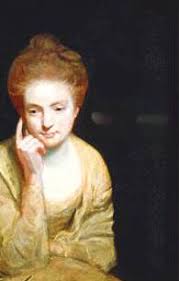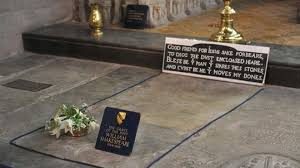By: Loren Miller
King Lear
William Shakespeare
Glossary/Translation of Words
(From beginning to end)
Moiety:
Definition: A half, one of two equal parts. (O.E.D.)
Ex. from the work:
“…that curiosity in neither can make choice of either’s moiety.” (p.1255; 1.1 5-6)
Issue:
Definition: Offspring, children, descendants (also occas. with singular reference). Also occas. with reference to animals. Also fig. Now chiefly in legal contexts or with reference to family history. (O.E.D.) 5a.
Ex. from the work:
“I cannot wish the fault undone, the issue of it being so proper.” (p.1255; 1.1 16-17)
Knave:
Definition: In weakened use. A man or boy whose behaviour invites disapproval, but who is nonetheless likeable; a wag, a rogue (rogue n. 3). Frequently as a term of endearment, or as a playful term of reproof. (O.E.D.) 3b.
Ex. from the work:
“Though this knave came something saucily into the world before he was sent for, yet was his mother fair; there was good sport at his making, and the whoreson must be acknowledged.” (p.1255; 1.1 20-23)
Liege:
Definition: The characteristic epithet of persons in the relation of feudal superior and vassal. (O.E.D.)
Ex. from the work:
“I shall, my liege.” (p.1255; 1.1 34)
Wield:
Definition: To express, utter. (O.E.D.) 4d.
Ex. from the work:
“Sir, I love you more than words can wield the matter…” (p. 1256; 1.1 53-54)
Bond:
Definition: Obligation, duty. (O.E.D) 6b.
Ex. from the work:
“I love your majesty according to my bond; no more nor less.” (p. 1257; 1.1 92-93)
Haply:
Definition: Perhaps, possibly; maybe. (O.E.D.)
Ex. from the work:
“Haply, when I shall wed, that Lord whose hand must take my plight shall carry half my love with him, half my care and duty.” (p. 1257; 1.1 100-02)
Plight:
Definition: To pledge or bind oneself to do or give (something); to promise. (O.E.D.) 3.
Ex. from the work:
“Haply, when I shall wed, that Lord whose hand must take my plight shall carry half my love with him, half my care and duty.” (p.1257; 1.1 100-02)
Hecate:
Definition: In ancient Greek mythology, a goddess, said to be of Thracian origin, daughter of Perses and Asteria; in later times more or less identified with several others, esp. with Artemis. (O.E.D.)
Ex. from the work:
“For, by the sacred radiance of the sun, the mysteries of Hecate, and the night…” (p. 1257; 1.1 110-11)
Scythian:
Definition: Of or relating to Scythia, an ancient region extending over a large part of European and Asiatic Russia, or to the nomadic people by whom it was inhabited. (O.E.D.)
Ex. from the work:
“The barbarous Scythian, or he that makes his generation messes to gorge his appetite, shall to my bosom be as well neighbored, pitied, and relieved, as thou my sometime daughter.” (p. 1257; 117-19)
Coronet:
Definition: A small or inferior crown; spec. a crown denoting a dignity inferior to that of the sovereign, worn by the nobility, and varying in form according to rank.
Ex. from the work:
“Only we still retain the name, and all the additions to a king; the sway, revenue, execution of the rest, beloved son, be yours; which to confirm, this coronet part betwixt you.” (p. 1258; 1.1 136-40)
Betwixt:
Definition: Between prep., adv., and n., in the various senses of that word. (O.E.D.)
Ex. from the work:
“Only we still retain the name, and all the additions to a king; the sway, revenue, execution of the rest, beloved son, be yours; which to confirm, this coronet part betwixt you.” (p. 1258; 1.1 136-40)
Miscreant:
Definition: An unbeliever; a heretic, infidel. (O.E.D.) B1a.
Ex. from the work:
“O, vassal! miscreant!” (p.1258; 1.1 164)
Recreant:
Definition: A person who breaks allegiance or faith, or neglects a duty; an apostate, a deserter. Also gen., as a term of abuse: a villain. (O.E.D.) 2a.
Ex. from the work:
“Hear me, recreant!” (p.1259; 1.1 169)
Compliment:
Definition: A ceremonial act or expression as a tribute of courtesy. (O.E.D.)
Ex. from the work:
“There is further compliment of leave-taking between France and him.” (p. 1262; 1.1 303-04)
Fops:
Definition: A foolish person, a fool. (O.E.D.)
Ex. from the work:
“…Go to creating a whole tribe of fops…” (p. 1263; 1.2 14)
Speed:
Definition: To succeed or prosper; to meet with success or good fortune; to attain one’s purpose or desire. (O.E.D.)
Ex. from the work:
“Well, my legitimate, if this letter speed, and my invention thrive, Edmund the base shall top the legitimate.” (p. 1263; 1.2 19-21)
Frame:
Definition: To pre-arrange (something). (O.E.D.) 11a.
Ex. from the work:
“I pray you; frame the business after your own wisdom.” (p.1264-65; 1.2 28-99)
Surfeit:
Definition: A particular instance of such behaviour; a gluttonous act; an excessive indulgence in food or drink, esp. one leading to discomfort or illness. (O.E.D.) 1b.
Ex. from the work:
“This is the excellent foppery of the world, that, when we are sick in fortune, often the surfeit of our own behavior, we make guilty of our disasters the sun, the moon, and the stars…” (p. 1265; 1.2 117-20)
Forbear:
Definition: To avoid, shun; to keep away from or keep from interfering with; to leave alone. (O.E.D.) 4c.
Ex. from the work:
“Bethink yourself wherein you may have offended him; and at my entreaty forbear his presence till some little time hath qualified the heat of his displeasure…” (p. 1266; 1.2 156-58)
Upbraids:
Definition: To censure, find fault with, carp at. (O.E.D.) b.
Ex. from the work:
“His knights grow riotous, and himself upbraids us on every trifle.” (p. 1267; 1.3 7-8)
Idle:
Definition: Void of meaning or sense; foolish, silly, incoherent; also (of persons) light-headed, out of one’s mind, delirious. (O.E.D.) 2b.
Ex. from the work:
“Idle old man, that still would manage those authorities that he hath given away!” (p. 1267; 1.3 17-19)
Coxcomb:
Definition: A cap worn by a professional fool. (O.E.D.)
Ex. from the work:
“Let me hire him too. Here’s my coxcomb.” (p.1270; 1.4 93)
Apish:
Definition: Ape-like in imitation; unreasoningly imitative. (O.E.D.)
Ex. from the work:
“Their manners are so apish.” (p.1271; 1.4 164)
Fain:
Definition: Gladness, joy. (O.E.D.)
Ex. from the work:
“I would fain learn to lie.” (p.1271; 1.4. 174)
Caitiff:
Definition: Expressing commiseration: A wretched miserable person, a poor wretch, one in a piteous case. (O.E.D.)
Ex. from the work:
“That he which finds him shall deserve out thanks, bringing the murderous caitiff to the stake; he that conceals him, death.” (p.1278; 2.1 62-64)
Varlet:
Definition: A person of a low, mean, or knavish disposition; a knave, rogue, rascal. (O.E.D.)
Ex. from the work:
“What a brazen-faced varlet art thou, to deny thou knowest me!” (p. 1281; 2.2 25-26)
Fleshment:
Definition: The action of ‘fleshing’; hence, the excitement resulting from a first success. (O.E.D.)
Ex. from the work:
“…and, in the fleshment of this dread exploit, drew on me here again.” (p. 1283; 2.2 18-19)
Bedlam:
Definition: The town of Bethlehem in Judea. (O.E.D.)
Ex. from the work:
“ The country gives me proof and precedent of Bedlam beggars, who, with roaring voices, strike in their numbed and mortified bare arms pins, wooden pricks, nails, springs of rosemary…” (p.1285; 2.3 13-16)
Sumpter:
Definition: The driver of a pack-horse. (O.E.D.)
Ex. from the work:
“Persuade me rather to be slave and sumpter to this detested groom.” (p.1291; 2.4 213-14)
Germens:
Definition: A plant embryo within a seed; (also) the plumule of the embryo in a germinating seed. (O.E.D.) b.
Ex. from the work:
“Crack nature’s molds, all germens spill at once, that make ingrateful man!” (p. 1295; 3.2 8-9)
Cutpurses:
Definition: One who steals by the method of cutting purses, a common practice when men wore their purses at their girdles’ (Johnson); hence, a pickpocket, thief, robber; also fig.
Ex. from the work:
“…when slanders do not live in tongues, nor cutpurses come not to throngs…” (p. 1297; 3.2 87-88)
Brach:
Definition: A term of abuse. Cf. bitch. (O.E.D.) b.
Ex. from the work:
“Be thy mouth or black and white, tooth that poisons if it bite, mastiff, greyhound, mongrel grim, hound or spaniel, brach or lym…” (p. 1305; 3.6 66-69)
Flibbertigibbet:
Definition: A chattering or gossiping person; a flighty or frivolous woman. (O.E.D.)
Ex. from the work:
“…Flibbertigibbet, of mopping and mowing, who since possesses chambermaids and waiting-women.” (p.1311; 4.1 62-63)
Cowish:
Definition: Cowardly. (O.E.D.)
Ex, from the work:
“It is the cowish terror of his spirit, that dares not undertake.” (p. 1312; 4.2 12-13)
Ado:
Definition: Trouble, difficulty. (O.E.D.) number 3.
Ex. from the work:
“Madam, with much ado. Your sister is the better soldier.” (p. 1317; 4.5 3-4)
Seconds:
Definition: To support. (O.E.D.)
Ex. from the work:
“No seconds? All myself?” (p.1323; 4.6 191)
Machination:
Definition: An instance of plotting or (usually malicious) contrivance; an intrigue, plot, or scheme. (O.E.D.)
Ex. from the work:
“Your business of the world hath so an end, and machination ceases.”(p.1329; 5.1 45-46)
Puissant:
Definition: Possessed of or wielding power; having great authority or influence; mighty, potent, powerful. (O.E.D.)
Ex. from the work:
“His grief grew puissant, and the strings of life began to crack.” (p. 1336; 5.3 216-17)
Books used:
The Norton Anthology English Literature:
The Sixteenth Century/The Early Seventeenth Century
9th Edition. Volume B.
Oxford English Dictionary





 Ben Jonson
Ben Jonson “True happiness Consists not in the multitude of friends, But in the worth and choice.”-Ben Jonson
“True happiness Consists not in the multitude of friends, But in the worth and choice.”-Ben Jonson







 Works Cited
Works Cited